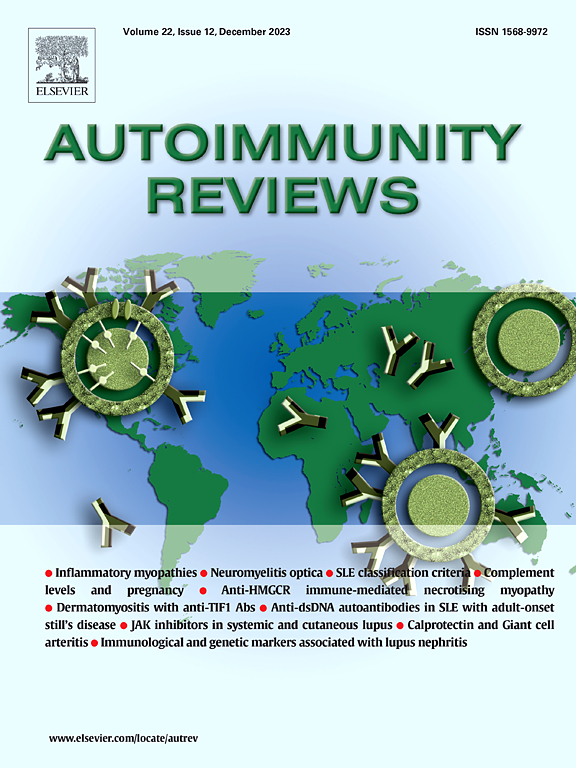1990-2021 年可改变的自身免疫性疾病风险因素造成的全球负担:时间趋势和社会人口不平等。
IF 9.2
1区 医学
Q1 IMMUNOLOGY
引用次数: 0
摘要
背景:自身免疫性疾病是由性别和遗传倾向等不可改变的风险因素以及生活方式选择和环境暴露等可改变的因素共同造成的。考虑到改变可改变风险因素的潜力,本研究旨在评估 1990 年至 2021 年间可改变风险因素导致的自身免疫性疾病的全球负担、时间趋势和不平等现象。这项研究将提供最新证据,为减轻这些风险因素对全球自身免疫性疾病的影响的战略提供依据:方法:从《2021 年全球疾病负担研究》(Global Burden of Diseases study 2021)中获得了关于可改变风险因素导致的自身免疫性疾病全球负担的数据。通过估计年度百分比变化(EAPC)评估了年龄标准化残疾调整生命年(DALYs)比率的时间趋势。斯皮尔曼秩相关检验用于探讨两个变量之间的关联。不平等斜率指数(SII)和集中指数(CI)分别用于评估残疾调整寿命年率和数量的绝对和相对不平等:从 1990 年到 2021 年,高温导致的 1 型糖尿病(T1DM)的全球年龄标准化残疾调整寿命年率呈上升趋势(EAPC = 0.88,0.58 至 1.18),而由特定风险因素导致的所有其他自身免疫性疾病总体上呈下降趋势。在社会人口指数(SDI)五分位数中,高 SDI 国家因高温导致的 T1DM 发病率显著上升(EAPC = 1.36,0.92 至 1.80),低 SDI 国家和低 SDI 国家的 T1DM 发病率则显著下降(EAPC = 0.88,0.58 至 1.18)。在低 SDI 和中低 SDI 国家,吸烟会导致多发性硬化症(EAPC = 0.25,0.23 至 0.27;0.22,0.21 至 0.23);在中低 SDI 国家,高体重指数(BMI)会导致哮喘(EAPC = 0.25,0.20 至 0.29)。2021 年,在 204 个国家和地区中,类风湿性关节炎(RA)和多发性硬化症(MS)因吸烟导致的年龄标准化残疾调整寿命年率,以及 T1DM 因低温导致的年龄标准化残疾调整寿命年率,在 SDI 和年龄标准化残疾调整寿命年率之间都出现了明显的正相关(均为 P 结论):在过去的三十年中,除高温导致的 T1DM 外,在降低可改变风险因素导致的自身免疫性疾病的全球年龄标准化残疾调整寿命年数方面取得了重大进展。尽管取得了这些进展,但在这些由风险因素引起的疾病中,大多数与 SDI 相关的不平等现象仍保持稳定,这表明迫切需要制定有针对性的公共卫生战略来解决这些持续存在的不平等现象。本文章由计算机程序翻译,如有差异,请以英文原文为准。
Global burden due to modifiable risk factors for autoimmune diseases, 1990–2021: Temporal trends and socio-demographic inequalities
Background
Autoimmune diseases arise from a combination of non-modifiable risk factors, such as gender and genetic predispositions, and modifiable factors, including lifestyle choices and environmental exposures. Given the potential to alter modifiable risk factors, this study aims to evaluate the global burden, temporal trends, and inequalities of autoimmune diseases attributed to modifiable risk factors from 1990 to 2021. The study will provide up-to-date evidence to inform strategies for mitigating the impact of these risk factors on autoimmune diseases worldwide.
Methods
Data on the global burden of autoimmune diseases attributed to modifiable risk factors were obtained from the Global Burden of Diseases study 2021. Temporal trends in age standardized disability-adjusted life-years (DALYs) rates were evaluated by estimated annual percentage changes (EAPC). Spearman rank correlation test was used to explore the association between two variables. Slope index of inequality (SII) and concentration index (CI) were used to evaluated the absolute and relative inequalities in DALY rates and numbers, respectively.
Results
From 1990 to 2021, type 1 diabetes mellitus (T1DM) due to high temperature has shown an increasing trend in global age standardized DALY rates (EAPC = 0.88, 0.58 to 1.18), whereas all other autoimmune diseases due to specific risk factors have generally exhibited decreasing trends. Across Socio-demographic Index (SDI) quintiles, notable increases were observed in high SDI countries for T1DM due to high temperature (EAPC = 1.36, 0.92 to 1.80), in low and low-middle SDI countries for multiple sclerosis (MS) due to smoking (EAPC = 0.25, 0.23 to 0.27; 0.22, 0.21 to 0.23, respectively), and in low-middle SDI countries for asthma due to high body-mass index (BMI) (EAPC = 0.25, 0.20 to 0.29). In 2021, significant positive associations were observed between SDI and age-standardized DALY rates for rheumatoid arthritis (RA) and MS due to smoking, as well as T1DM due to low temperatures across 204 countries and territories (all P < 0.05). In contrast, all other autoimmune diseases attributed to certain risk factors exhibited significant negative associations (all P < 0.05). Women displayed higher global age-standardized DALY rates for asthma due to high BMI (44.1 per 100,000 population), while men exhibited higher global age-standardized DALY rates for all other autoimmune diseases due to specific risk factors. Except for narrowed inequalities in DALY rates for asthma due to smoking (SII = 20.4, 13.0 to 27.8 in 1990 to 6.7, 2.8 to 10.6 in 2021) and in DALY numbers for asthma due to high BMI (CI = 17.3, 24.5 to 9.5 in 1990 to −0.3, 8.2 to −8.6 in 2021), both absolute and relative SDI-related inequalities have remained stable for all other autoimmune diseases linked to specific risk factors.
Conclusions
Over the past three decades, substantial progress has been achieved in reducing global age-standardized DALY rates for autoimmune diseases attributed to modifiable risk factors, except for T1DM attributed to high temperatures. Despite these advancements, SDI-related inequalities have remained stable for most of these diseases attributed to risk factors, underscoring the urgent need for targeted public health strategies to address these persistent disparities.
求助全文
通过发布文献求助,成功后即可免费获取论文全文。
去求助
来源期刊

Autoimmunity reviews
医学-免疫学
CiteScore
24.70
自引率
4.40%
发文量
164
审稿时长
21 days
期刊介绍:
Autoimmunity Reviews is a publication that features up-to-date, structured reviews on various topics in the field of autoimmunity. These reviews are written by renowned experts and include demonstrative illustrations and tables. Each article will have a clear "take-home" message for readers.
The selection of articles is primarily done by the Editors-in-Chief, based on recommendations from the international Editorial Board. The topics covered in the articles span all areas of autoimmunology, aiming to bridge the gap between basic and clinical sciences.
In terms of content, the contributions in basic sciences delve into the pathophysiology and mechanisms of autoimmune disorders, as well as genomics and proteomics. On the other hand, clinical contributions focus on diseases related to autoimmunity, novel therapies, and clinical associations.
Autoimmunity Reviews is internationally recognized, and its articles are indexed and abstracted in prestigious databases such as PubMed/Medline, Science Citation Index Expanded, Biosciences Information Services, and Chemical Abstracts.
 求助内容:
求助内容: 应助结果提醒方式:
应助结果提醒方式:


